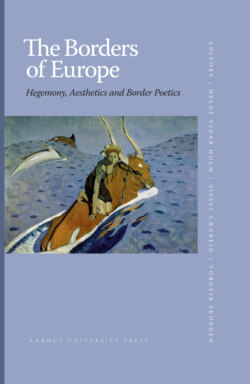The Borders of Europe

Реклама. ООО «ЛитРес», ИНН: 7719571260.
Оглавление
Группа авторов. The Borders of Europe
Introduction: The Notion of Europe, its Origins and Imaginaries
Bibliography
Hegemonic Ideals: Turkish Architecture of the 20th Century
Politics and architecture
Ottoman-European architecture as the façade of modernity
The First National Style
Windows to the West and international (state) modernism
Neo-Ottoman brutalism: The Second National Style
Bibliography
Region and Frontier in the English State: Co. Meath and the English Pale, 1460-15421
Bibliography. i) Manuscript Sources
ii) Printed Sources
iii) Secondary literature
Russian History and European Ideas: The Historical Vision of Vasilii Kliuchevskii
Progress and Retardation
The Russian People and the Russian Land
The Rise and Decline of Russian Nationhood
Restoring the Balance
Russia, Europe and Kliuchevskii
Bibliography
Excluding the West: Nataliia Narochnitskaia’s Romantic-Realistic Image of Europe
Introduction: the Romantic Realist Hegemony
Nataliia Narochnitskaia – a Child of the Cold War
Narochnitskaia’s Weltanschauung
The Religious Dimension: A Moral View of History
The Geopolitical Dimension: “The Eastern Question”
The Historiographic Dimension: Ahistorical Historiography
Conclusion: Impossible Invitation
Bibliography
The Text-Catena in the Frescoes in the Sanctuary of S. Maria Antiqua in Rome (705-707 A.D.): An Index of Cultural Cross-Over in 7th-8th century Rome?1
Preamble
The frescoes of John VII in the church of S. Maria Antiqua
The Constantinopolitan Thesis
The Palestinian Connection. Palestinian influence on the Old Testament text-catena on the Triumphal Arch: A Hypothesis. An ambiguity explored
Table according to S. Janeras
The eschatological level: Cyril’s 15th Catechesis
Triumphal arch, lower zone: “The Resurrection of the Dead”?
Rome as a melting pot of cultural migration
Bibliography
A Metaphorical View on Cultural Dialogues: Struve’s Meridian Arc and Reflections on Memories in Eastern and Northern Borderlands
Bibliography
Multiple Dimensions and Multiple Borderlines: Cultural Work and Borderline Experience
Bibliography
The Colonizer and the Colonized: On the Orientalized Caucasus as Alter and Alternative Ego in Russian Classical Literature
Bibliography
Time and Causality in Flaubert’s Novels Salammbô and Bouvard et Pécuchet
Bibliography
Mozart’s Opera The Abduction from the Seraglio and Bakhtin’s Border Poetics
Bibliography
The Female Body, Landscape and National Identity
Femininity, women artists and contemporary historical landscapes
A K Dolven: between two mornings
Mari Slaattelid and Lars Hertervig
The birth of the nation and of art
The female body and the Nordic feeling for nature
The female body and landscapes
Slaattelid, Dolven and the desire for more
Bibliography
Internet resources:
On the Borders of Poetry and Art
PART I. Introduction
Ut pictura poesis
Lessing’s Laokoon – establishing aesthetic borders
PART II
From interart studies to intermediality studies
Defining medium
Media borders and intermediality
Bibliography
Writing Exile, Writing Home: Translocation and Self-Narration in Eva Hoffman’s Lost in Translation
Three Parts: Nostalgia, Alienation, Reconciliation
Transplantation and Cultural Metamorphosis
Self-Narration: Constructing a “Home” in Language
Bibliography
Poems and Poets in Transit: Heterochronic Cross-Border Acts or the Aesthetics of Exile in 20th Century German-Jewish Poetry
Bibliography
The Threshold Returns the Gaze: Border Aesthetics in Disciplined Space
Border discipline
The disembodied eye
“Threshold knowledge”
“Thingness”
Bibliography
Authors’ Biographies
Отрывок из книги
Helge Vidar Holm,
Sissel Lægreid,
.....
A major precondition for the emergence of this new philosophical discipline, and along with it the rise of modern nationalism, was a fundamental shift of the European time conception, which Walter Benjamin has described as a turn from the Messianic time conception of the Middle Ages to the modern conception of time as “empty” and “homogenous” (cf. Benjamin 1997: 700-703). According to the Messianic time conception, time was inseparably linked to the place and to the expectation that Messiah would return at any point of time. It was therefore unnecessary to conceive of time in more extensive historical lines. To the medieval mind, there was a “now” that was inseparably linked to a “here”. Time only existed if it “took place” and was conceived of as an expandable moment which was inseparably tied to the locality in which it was experienced. Places far away were accordingly projected far back in time.
In the wake of new 18th century discoveries and technical inventions, such as the invention of the chronometer and the synchronization of the homogenous global time by the division of time meridians, time could be gradually separated from space, and a new conception of time as empty and homogenous emerged (cf. Anderson 1996: 22-36). To the medieval mind, time had been filled with mythological and religious meaning and stories, serving as moral examples. In the new homogenous time conception, these stories were replaced by history, which in turn was filled with new meanings and narratives, such as the concept of progress.
.....